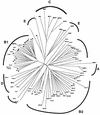Healthy skin of many animal species harbors papillomaviruses which are closely related to their human counterparts
- PMID: 12438579
- PMCID: PMC136724
- DOI: 10.1128/jvi.76.24.12537-12542.2002
Healthy skin of many animal species harbors papillomaviruses which are closely related to their human counterparts
Abstract
Papillomaviruses associated with clinical symptoms have been found in many vertebrate species. In this study, we have used an L1 gene consensus PCR test designed to detect a broad spectrum of human skin papillomaviruses to analyze swab samples from healthy skin of 111 animals belonging to 19 vertebrate species. In eight of the species, papillomavirus DNA was found with the following prevalences: chimpanzees, 9 of 11 samples positive; gorillas, 3 of 4; long-tailed macaques, 14 of 16; spider monkeys, 2 of 2; ruffed lemurs, 1 of 2; cows, 6 of 10; European elks, 4 of 4; aurochs, 1 of 1. In total, 53 new putative animal papillomavirus types were found. The results show that skin papillomaviruses can be detected in healthy skin from many different animal species and are sufficiently related genetically to their human counterparts to be identified by a human skin papillomavirus primer set (FAP59 and FAP64).
Figures

References
-
- Astori, G., D. Lavergne, C. Benton, B. Hockmayr, K. Egawa, C. Garbe, and E. M. de Villiers. 1998. Human papillomaviruses are commonly found in normal skin of immunocompetent hosts. J. Investig. Dermatol. 110:752-755. - PubMed
-
- Bernard, H. U. 1994. Coevolution of papillomaviruses with human populations. Trends Microbiol. 2:140-143. - PubMed
-
- Boxman, I. L., R. J. Berkhout, L. H. Mulder, M. C. Wolkers, J. N. B. Bavinck, B. J. Vermeer, and J. ter Schegget. 1997. Detection of human papillomavirus DNA in plucked hairs from renal transplant recipients and healthy volunteers. J. Investig. Dermatol. 108:712-715. - PubMed
-
- Campo, M. S. 1997. Bovine papillomavirus and cancer. Vet. J. 154:175-188. - PubMed
Publication types
MeSH terms
Substances
Associated data
- Actions
- Actions
- Actions
- Actions
- Actions
- Actions
- Actions
- Actions
- Actions
- Actions
- Actions
- Actions
- Actions
- Actions
- Actions
- Actions
- Actions
- Actions
- Actions
- Actions
- Actions
- Actions
- Actions
- Actions
- Actions
- Actions
- Actions
- Actions
- Actions
- Actions
- Actions
- Actions
- Actions
- Actions
- Actions
- Actions
- Actions
- Actions
- Actions
- Actions
- Actions
- Actions
- Actions
- Actions
- Actions
- Actions
- Actions
- Actions
- Actions
- Actions
- Actions
- Actions
- Actions
- Actions
LinkOut - more resources
Full Text Sources
Other Literature Sources

